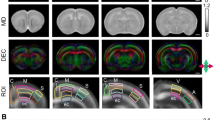Abstract
Objective.
In the present study, we examined the behavior and state of water molecules in immature and mature rat brains by measuring the components of magnetic resonance (MR) water proton transverse relaxation time (T 2). We also performed morphological examination of immature and mature rat brains using electron microscopy (EM). We then compared the fraction of T 2 component and the EM findings.
Methods.
Midbrains of male Wistar rats were examined at various time points ranging from 4 h to 12 weeks after birth. T 2 was measured by MR, and the ratios of intra- to extracellular spaces were determined by EM in each stage.
Results.
T 2 consisted of two components: fast T 2 (<100 ms), and slow T 2 (>100 ms). During maturation, values of fast T 2 decreased dramatically, but slow T 2 remained constant. However, the fraction accounted for by slow T 2 decreased from 59% to 9% during maturation. Morphological examination showed that the extracellular space fraction of the midbrain decreased from 49% to 5% during maturation. Thus, morphological change correlated well with changes in slow T 2; in other words, multicomponent T 2 results showed a close correlation with tissue compartmentalization.
Conclusion.
MR relaxation times obtained by means of multicomponent analysis can thus be used to measure intra- and extracellular space fractions.


Similar content being viewed by others
References
Bakay L, Kurland RJ, Parrish RG, Lee JC, Peng RJ, Bartkowski HM (1975) Nuclear magnetic resonance studies in normal and edematous brain tissue. Exp Brain Res 23:241–248
Barnes D, McDonald WI, Johnson G, Tofts PS, Landon DN (1987) Quantitative nuclear magnetic resonance imaging: characterisation of experimental cerebral oedema. J Neurol Neurosurg Psychiatry 50:125–133
Bondareff W, Narotzky R (1972) Age change in the neuronal microenvironment. Science 176:1135–1136
Bourke RS, Greenberg ES, Tower DB (1965) Variations of cerebral cortex fluid spaces in vivo as a function of species brain size. Am J Physiol 208:682–692
Carr HY, Purcell EM (1954) Effects of diffusion on free precession in nuclear magnetic resonance experiments. Phys Rev 94:630–638
Dea P, Chan SI, Dea FJ (1972) High-resolution proton magnetic resonance spectra of a rabbit sciatic nerve. Science 175:206–209
Eng LF, Noble EP (1968) The maturation of rat brain myelin. Lipids 3:157–162
Foster KR, Resing HA, Garroway AN (1976) Bounds on "bound water" tansverse nuclear magnetic resonance relaxation in barnacle muscle. Science 194:324–326
Haida M, Yamamoto M, Matsumura H, Shinohara Y, Fukuzaki M (1987) Intracellular and extracellular spaces of normal adult rat brain determined from the proton nuclear magnetic resonance relaxation times. J Cereb Blood Flow Metab 7:552–556
Horstmann E, Meves H (1959) Die Feinstruktur des molekulären Rindengraues und ihre physiologische Bedeutung. Z Zellforschung 49:569–604
Kleine LJ, Mulkern RV, Jolesz FA, Sandor T, Colucci VA, Zamaroczy D, Podell M (1992) Characterization of cerebral infarction by multicomponent analysis of transverse magnetization decay curves. Invest Radiol 27:422–428
Levin VA, Fenstermacher JD, Patlak CS (1970) Sucrose and inulin space measurements of cerebral cortex in four mammalian species. Am J Physiol 219:1528–1533
Matsumae M, Kurita D, Atsumi H, Haida M, Sato O, Tsugane R (2001) Sequential changes in MR water proton relaxation time detect the process of rat brain myelination during maturation. Mech Aging Dev 122:1281–1291
Meiboom S, Gill D (1958) Modified spin-echo method for measuring nuclear relaxation times. Rev Sci Instrum 29:688–691
Morell P, Quarles RH, Norton WT (1994) Myelin formation, structure, and biochemistry. In: Siegel GJ, Agranoff, BW, Albers RW, Molinoff PB (eds) Basic neurochemistry: molecular, cellular, and medical aspects, 5th edn. Raven Press, New York, pp 117–143
Naruse S, Horikawa Y, Tanaka C, Hirakawa K, Nishikawa H, Yoshizaki K (1982) Proton nuclear magnetic resonance studies on brain edema. J Neurosurg 56:747–752
Rall DP, Oppelt WW, Patlak CS (1962) Extracellular space of brain as determined by diffusion of inulin from the ventricular system. Life Sci 2:43–48
Rees S, Cragg BG, Everitt AV (1982) Comparison of extracellular space in the mature and ageing rat brain using a new technique. J Neurol Sci 53:347–357
Stewart WA, MacKay AL, Whittall KP, Moore W, Paty DW (1993) Spin-spin relaxation in experimental allergic encephalomyelitis. Analysis of CPMG data using a non-linear least squares method and linear inverse theory. Magn Reson Med 29:767–775
Van Harreveld A (1961) Asphyxial changes in cerebellar cortex. J Cell Comp Physiol 57:101–110
Author information
Authors and Affiliations
Corresponding author
Rights and permissions
About this article
Cite this article
Matsumae, M., Oi, S., Watanabe, H. et al. Distribution of intracellular and extracellular water molecules in develo** rat's midbrain: comparison with fraction of multicomponent T 2 relaxation time and morphological findings from electron microscopic imaging. Childs Nerv Syst 19, 91–95 (2003). https://doi.org/10.1007/s00381-002-0695-8
Received:
Published:
Issue Date:
DOI: https://doi.org/10.1007/s00381-002-0695-8




